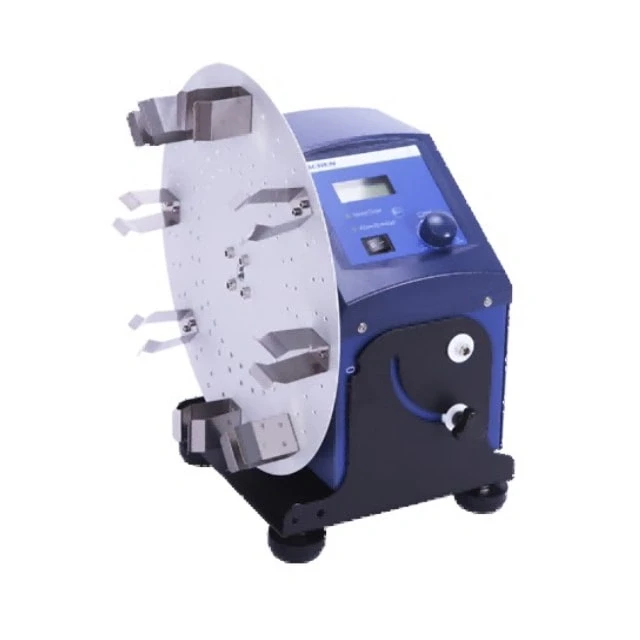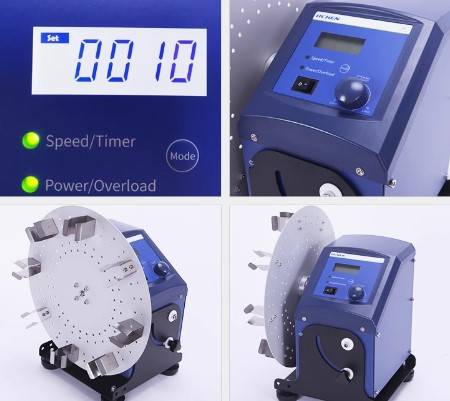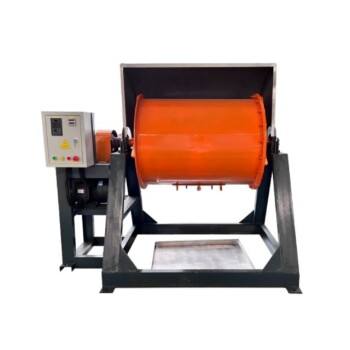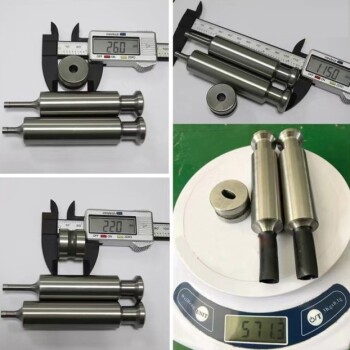
Shaking and mixing equipment
Laboratory Disc Rotary Mixer for Efficient Sample Mixing and Homogenization
Item Number : KTL-7
Price varies based on specs and customizations
- Motion mode
- Rotation
- Voltage
- 100-240VAC
- Power
- 40W
Shipping:
Contact us to get shipping details Enjoy On-time Dispatch Guarantee.
Why Choose Us
Reliable PartnerEasy ordering process, quality products, and dedicated support for your business success.
Introduction
The laboratory disc rotary mixer can rotate samples smoothly and effectively for mixing, homogenizing and extraction. It adopts DC motor and microcomputer control technology, unique knob operation mode, simple and easy to use, and can run for a long time. It is easy to remove accessories for quick cleaning when samples overflow. By replacing different trays, various commonly used test tubes (1.5-50ml samples) can be mixed.
Detail & Parts


Technical Parameters
| Model | LC-TD |
|---|---|
| Motion mode | Rotation |
| Voltage | 100-240VAC |
| Frequency | 50/60Hz |
| Power | 40W |
| Angle | 0-90° |
| Motor type | DC motor |
| Speed range | 10-70RPM |
| Time setting range | 1-1199min |
| Operation mode | Timed/continuous operation |
| Product size | D280×W210×H300mm |
| Net weight of product | 8Kg |
| Permissible ambient temperature | 5-40℃ |
| Permissible relative humidity | 80%RH |
| Enclosure protection level | IP21 |
Features
- The LCD display can display the speed and timing at the same time, and the speed and timing can be set electronically for more precise control;
- A variety of disc clamps, suitable for 1.5-50ml microtubes, up to four layers of discs can be accumulated;
- The angle can be adjusted from 0-90°, which is convenient for sample mixing and fixture removal and installation;
- Rotary motion, gentle and full mixing;
- Adjustable speed, up to 70rpm;
- Two operating modes can be selected: timed operation or continuous operation;
- Electric high-efficiency DC motor drive, stable operation, low noise and long service life;
- Wide voltage design, effectively avoiding interference of unstable network power supply to the instrument;
Designed for You
KinTek provide deep custom made service and equipment to worldwide customers, our specialized teamwork and rich experienced engineers are capable to undertake the custom tailoring hardware and software equipment requirements, and help our customer to build up the exclusive and personalized equipment and solution!
Would you please drop your ideas to us, our engineers are ready for you now!
4.7
out of
5
Exceptional value for money, this mixer has streamlined our lab processes with its precise control and efficient mixing capabilities.
4.8
out of
5
Highly durable and technologically advanced, this mixer has become indispensable in our lab for its reliability and performance.
4.9
out of
5
The speed of delivery was impressive, and the mixer itself has exceeded our expectations in terms of quality and efficiency.
4.7
out of
5
This mixer offers unparalleled versatility, handling a wide range of samples with ease and precision.
4.8
out of
5
The mixer's compact design and easy portability have made it a favorite in our lab for its convenience and effectiveness.
4.9
out of
5
Impressive build quality and advanced features make this mixer a top choice for our lab's mixing needs.
4.7
out of
5
The mixer's adjustable speed and angle settings provide the flexibility we need for various lab applications.
4.8
out of
5
This mixer has significantly improved our lab's efficiency with its reliable performance and easy maintenance.
4.9
out of
5
The mixer's gentle yet thorough mixing motion ensures consistent results, making it a valuable asset in our lab.
REQUEST A QUOTE
Our professional team will reply to you within one business day. Please feel free to contact us!
Related Products

Laboratory Vortex Mixer Orbital Shaker Multifunctional Rotation Oscillation Mixer
The inching mixer is small in size, mixes quickly and thoroughly, and the liquid is in a vortex shape, which can mix all the test solutions attached to the tube wall.

Lab Internal Rubber Mixer Rubber Kneader Machine for Mixing and Kneading
Lab internal rubber mixer is suitable for mixing, kneading and dispersing various chemical raw materials such as plastics, rubber, synthetic rubber, hot melt adhesive and various low-viscosity materials.

Custom PTFE Teflon Parts Manufacturer Laboratory High Temperature Mixing Paddle Mixer
The PTFE mixing paddle mixer is a versatile and robust tool designed for laboratory use, particularly in environments requiring high resistance to chemicals and extreme temperatures. Crafted from high-quality PTFE, this mixer boasts several key features that enhance its functionality and durability.

Stainless Steel Laboratory Ball Mill for Dry Powder and Liquid with Ceramic Polyurethane Lining
Discover the versatile stainless steel dry powder/liquid horizontal ball mill with ceramic/polyurethane lining. Ideal for ceramic, chemical, metallurgical, and building materials industries. High grinding efficiency and uniform particle size.

Laboratory Muffle Oven Furnace Bottom Lifting Muffle Furnace
Efficiently produce batches with excellent temperature uniformity using our Bottom Lifting Furnace. Features two electric lifting stages and advanced temperature control up to 1600℃.

Engineering Advanced Fine Ceramics Alumina Al2O3 Crucible With Lid Cylindrical Laboratory Crucible
Cylindrical Crucibles Cylindrical crucibles are one of the most common crucible shapes, suitable for melting and processing a wide variety of materials, and are easy to handle and clean.

Laboratory Sterilizer Lab Autoclave Herbal Powder Sterilization Machine for Plant
The herbal powder sterilization autoclave machine for Chinese medicine uses saturated steam for effective sterilization. It utilizes the heat and penetrative properties of steam, achieves sterilization after heat preservation, and maintains a good drying effect with a dedicated drying system.

Laboratory Sterilizer Lab Autoclave Pulse Vacuum Lifting Sterilizer
The pulse vacuum lifting sterilizer is a state-of-the-art equipment for efficient and precise sterilization. It uses pulsating vacuum technology, customizable cycles, and a user-friendly design for easy operation and safety.

Desktop Fast Laboratory Autoclave Sterilizer 35L 50L 90L for Lab Use
The desktop fast steam sterilizer is a compact and reliable device used for rapid sterilization of medical, pharmaceutical, and research items. It efficiently sterilizes surgical instruments, glassware, medicines, and resistant materials, making it suitable for various applications.

Laboratory Vibratory Sieve Shaker Machine for Dry and Wet Three-Dimensional Sieving
KT-VD200 can be used for sieving tasks of dry and wet samples in the laboratory. The screening quality is 20g-3kg. The product is designed with a unique mechanical structure and an electromagnetic vibrating body with a vibration frequency of 3000 times per minute.

Multi-Punch Rotary Tablet Press Mold Ring for Rotating Oval and Square Molds
The multi-punch rotary tablet press mold stands as a pivotal component in pharmaceutical and manufacturing industries, revolutionizing the process of tablet production. This intricate mold system comprises multiple punches and dies arranged in a circular fashion, facilitating rapid and efficient tablet formation.
Related Articles

Basic Mixing Equipment in the Laboratory
Overview of essential laboratory mixing devices and their functionalities.

Basic Laboratory Centrifuge Equipment
Overview of different types of centrifuges used in laboratories.

Understanding the Rotating Disk Electrode: Principles and Applications
Explores the development, principles, and applications of the rotating disk electrode in electrochemistry.

Basic Laboratory Culture Equipment
Overview of essential laboratory equipment for biological and microbiological research.

The Rise of Rotary Evaporators in Cocktail Bars
Exploring the use of rotary evaporators in modern cocktail bars, from London to Kansas, and their impact on cocktail creation.

Major Equipment in a Dental Laboratory
Overview of essential dental lab equipment including casting, porcelain, polishing, and more.

Choosing the Right Chamber Muffle Furnace Size
Guidelines for selecting the appropriate chamber size for a muffle furnace based on sample size, number of samples, process needs, and more.

Basic Principles and Applications of Rotating Disc Electrodes
Explores the development, principles, and applications of Rotating Disc Electrodes in electrochemistry.

How to Select the Right Oil-Free Diaphragm Pump for Your Lab or Industrial Needs
Learn how to choose the right oil-free diaphragm pump for your lab or industry—balancing specs, chemical resistance, and lifetime costs.

Sample Preparation Methods in X-ray Fluorescence and Their Impact on Test Results
Explores the tablet and melting methods in X-ray fluorescence, detailing their advantages, disadvantages, and key considerations.

The Art of the Shutdown: Engineering Reliability in Electrochemical Cells
Post-experiment procedures are not chores; they are the foundation of future accuracy. Learn the disciplined protocol for maintaining double-layer electrolytic cells.

Rotary Evaporator and Its Application in Traditional Chinese Medicine Refinement
Explores the use of rotary evaporators in the concentration and refinement of traditional Chinese medicine extracts, detailing equipment selection, operation principles, and safety considerations.